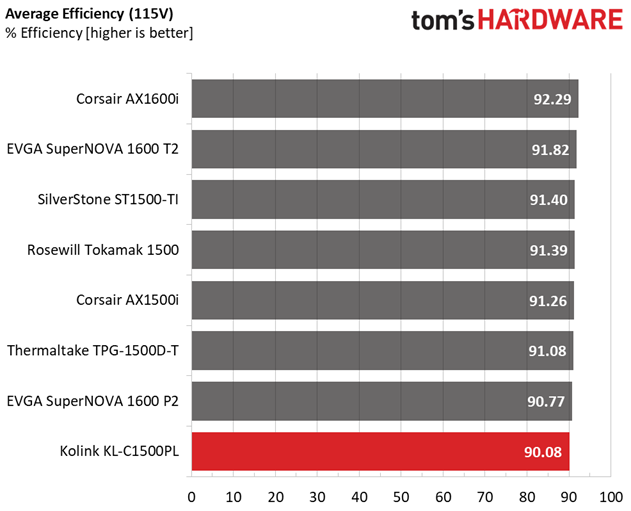Kolink Continuum KL-C1500PL PSU Review: Miner's Delight?
Why you can trust Tom's Hardware
Performance, Value, Noise & Efficiency
Performance Rating
The following graph shows the KL-C1500PL’s total performance rating, comparing it to other units we have tested. To be more specific, the tested unit is shown as 100 percent, and every other unit's performance is shown relative to it.
This PSU's relative performance score is quite good, given its price tag.
Performance Per Dollar
The following chart may be the most interesting to many of you because it depicts the unit's performance-per-dollar score. We looked up the current price of each PSU on popular online shops and used those prices and all relative performance numbers to calculate the index. If the specific unit wasn't available in the United States, we searched for it in popular European Union shops, converting the listed price to USD (without VAT). Note that all of the numbers in the following graph are normalized by the rated power of each PSU.
This is where we expect Kolink's KL-C1500PL to excel. If it hits a $300 price point once it becomes available in the US market (somewhere within 2018 as Kolink's PR told us), its performance per dollar score will trounce the competition.
Noise Rating
The graph below depicts the cooling fan's average noise over the PSU's operating range, with an ambient temperature between 30°C and 32°C (86°F to 89.6°F).
The KL-C1500PL is a noisy PSU. Our chart makes that much clear.
Efficiency Rating
The following graph shows the PSU's average efficiency throughout its operating range, with an ambient temperature close to 30°C.
Get Tom's Hardware's best news and in-depth reviews, straight to your inbox.
Efficiency-wise, Kolink doesn't fare so well against the EVGA 1600 P2. Then again, greater than 90% overall efficiency certainly can't be described as low, either.
MORE: Best Power Supplies
MORE: How We Test Power Supplies
MORE: All Power Supply Content
Current page: Performance, Value, Noise & Efficiency
Prev Page EMC Pre-Compliance Testing Next Page Final Analysis
Aris Mpitziopoulos is a contributing editor at Tom's Hardware, covering PSUs.
-
ozicom "The problem we see is that all eight-pin connectors have the same pattern, making it possible to accidentally connect an EPS cable to a PCIe socket and vice versa." Well I had a fully modular PSU in past and you can't connect eight pin of EPS to PCIe because the sockets may look same but they're not. If you look closer on top left two sockets of black and blue eight pins the notches are not same so you can't connect it. But if you tried and connect it it's a problem of course.Reply



